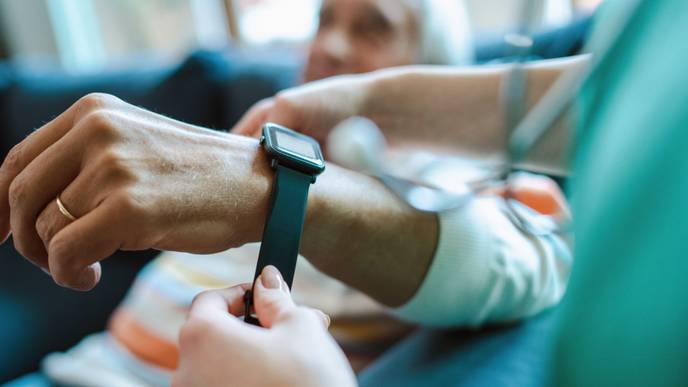ReachMD
Be part of the knowledge.™First-of-Their-Kind Wearables Capture Body Sounds to Continuously Monitor Health

During even the most routine visits, physicians listen to sounds inside their patients’ bodies — air moving in and out of the lungs, heart beats and even digested food progressing through the long gastrointestinal tract. These sounds provide valuable information about a person’s health. And when these sounds subtly change or downright stop, it can signal a serious problem that warrants time-sensitive intervention.
Now, Northwestern University researchers are introducing new soft, miniaturized wearable devices that go well beyond episodic measurements obtained during occasional doctor exams. Softly adhered to the skin, the devices continuously track these subtle sounds simultaneously and wirelessly at multiple locations across nearly any region of the body.
The new study was published today (Nov. 16) in the journal Nature Medicine.
In pilot studies, researchers tested the devices on 15 premature babies with respiratory and intestinal motility disorders and 55 adults, including 20 with chronic lung diseases. Not only did the devices perform with clinical-grade accuracy, they also offered new functionalities that have not been developed nor introduced into research or clinical care.
“Currently, there are no existing methods for continuously monitoring and spatially mapping body sounds at home or in hospital settings,” said Northwestern’s John A. Rogers, a bioelectronics pioneer who led the device development. “Physicians have to put a conventional, or a digital, stethoscope on different parts of the chest and back to listen to the lungs in a point-by-point fashion. In close collaborations with our clinical teams, we set out to develop a new strategy for monitoring patients in real-time on a continuous basis and without encumbrances associated with rigid, wired, bulky technology.”
“The idea behind these devices is to provide highly accurate, continuous evaluation of patient health and then make clinical decisions in the clinics or when patients are admitted to the hospital or attached to ventilators,”said Dr. Ankit Bharat, a thoracic surgeon at Northwestern Medicine, who led the clinical research in the adult subjects. “A key advantage of this device is to be able to simultaneously listen and compare different regions of the lungs. Simply put, it’s like up to 13 highly trained doctors listening to different regions of the lungs simultaneously with their stethoscopes, and their minds are synced to create a continuous and a dynamic assessment of the lung health that is translated into a movie on a real-life computer screen.”
Rogers is the Louis Simpson and Kimberly Querrey Professor of Materials Science and Engineering, Biomedical Engineering and Neurological Surgery at Northwestern’s McCormick School of Engineering and Northwestern University Feinberg School of Medicine. He also directs the Querrey Simpson Institute for Bioelectronics. Bharat is the chief of thoracic surgery and the Harold L. and Margaret N. Method Professor of Surgery at Feinberg. As the director of the Northwestern Medicine Canning Thoracic Institute, Bharat performed the first double-lung transplants on COVID-19 patients in the U.S. and started a first-of-its-kind lung transplant program for certain patients with stage 4 lung cancers.
Comprehensive, non-invasive sensing network
Containing pairs of high-performance, digital microphones and accelerometers, the small, lightweight devices gently adhere to the skin to create a comprehensive non-invasive sensing network. By simultaneously capturing sounds and correlating those sounds to body processes, the devices spatially map how air flows into, through and out of the lungs as well as how cardiac rhythm changes in varied resting and active states, and how food, gas and fluids move through the intestines.
Encapsulated in soft silicone, each device measures 40 millimeters long, 20 millimeters wide and 8 millimeters thick. Within that small footprint, the device contains a flash memory drive, tiny battery, electronic components, Bluetooth capabilities and two tiny microphones — one facing inward toward the body and another facing outward toward the exterior. By capturing sounds in both directions, an algorithm can separate external (ambient or neighboring organ) sounds and internal body sounds.
VIDEO
“Lungs don't produce enough sound for a normal person to hear,” Bharat said. “They just aren’t loud enough, and hospitals can be noisy places. When there are people talking nearby or machines beeping, it can be incredibly difficult. An important aspect of our technology is that it can correct for those ambient sounds.”
Not only does capturing ambient noise enable noise canceling, it also provides contextual information about the patients’ surrounding environments, which is particularly important when treating premature babies.
“Irrespective of device location, the continuous recording of the sound environment provides objective data on the noise levels to which babies are exposed,” said Dr. Wissam Shalish, a neonatologist at the Montreal Children’s Hospital and co-first author of the paper. “It also offers immediate opportunities to address any sources of stressful or potentially compromising auditory stimuli.”
Non-obtrusively monitoring babies’ breathing
When developing the new devices, the researchers had two vulnerable communities in mind: premature babies in the neonatal intensive care unit (NICU) and post-surgery adults. In the third trimester during pregnancy, babies’ respiratory systems mature so babies can breathe outside the womb. Babies born either before or in the earliest stages of the third trimester, therefore, are more likely to develop lung issues and disordered breathing complications.
Particularly common in premature babies, apneas are a leading cause of prolonged hospitalization and potentially death. When apneas occur, infants either do not take a breath (due to immature breathing centers in the brain) or have an obstruction in their airway that restricts airflow. Some babies might even have a combination of the two. Yet, there are no current methods to continuously monitor airflow at the bedside and to accurately distinguish apnea subtypes, especially in these most vulnerable infants in the clinical NICU
Facebook Comments